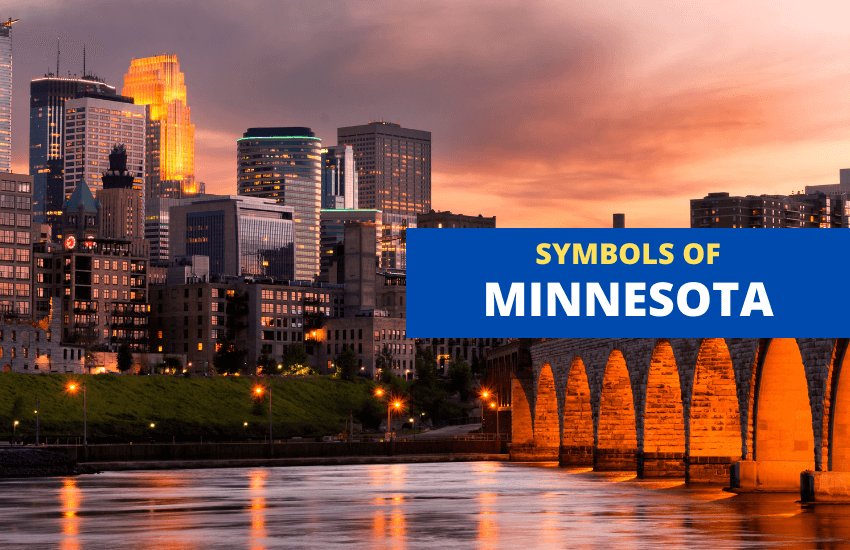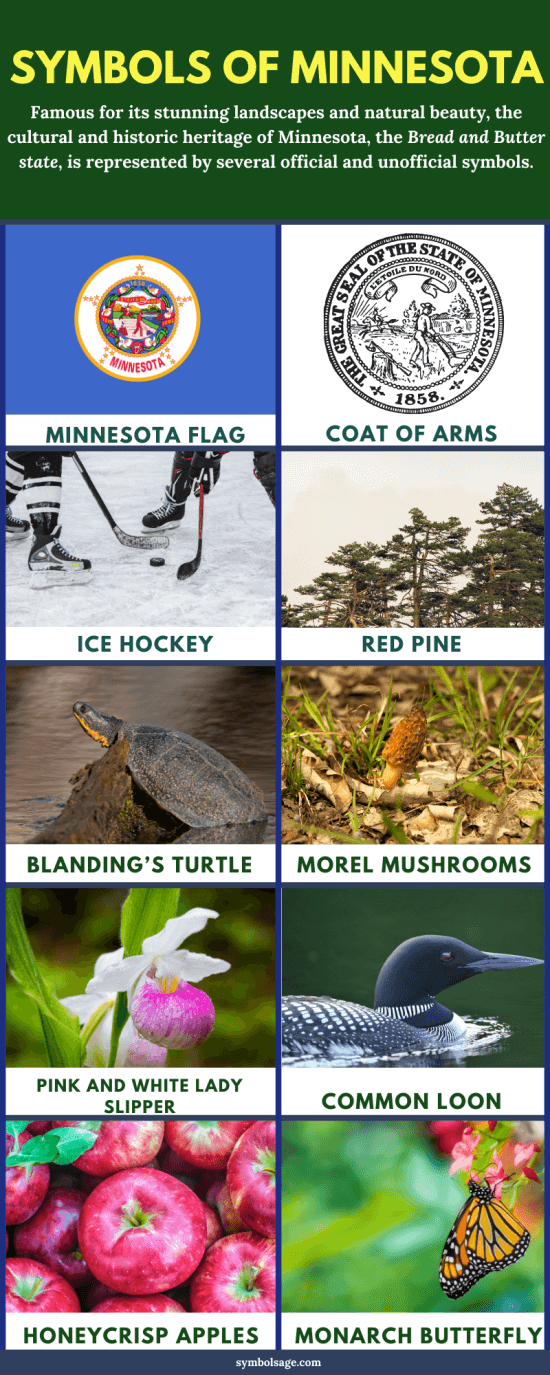
Table of Contents
Minnesota is one of the most popular states in the U.S, located in the Midwestern region and neighbor to Canada and the largest of all Great Lakes: Lake Superior. The state is well known for its forests and lakes and is also home to Minneapolis and St. Paul, the Twin Cities.
Famous for its cultural and natural beauty, Minnesota is a mix of hiking trails, waterways, wilderness and cultural attractions such as historic sites, heritage festivals and art museums. It’s also famous as the ‘Bread and Butter State’ because of its many butter-making plants and flourmills. Another nickname for it is the ‘Land of 10,000 Lakes’ since it has over 15,000 lakes.
Minnesota was admitted to the Union in May 1858 as the 32nd state of the U.S. Here’s a look at some of the most popular symbols of Minnesota.

State Flag of Minnesota
The official state flag of Minnesota features a modified version of the great seal in the center of a blue, rectangular background. A white circle in the center of the flag and around the seal contains the state name ‘MINNESOTA’ on the bottom, with one group of three stars and four groups of four stars evenly spread out around its edge.
At the top is another star which symbolizes the North Star. The design in the middle of the flag is surrounded by several pink and white lady’s slippers, the state flower of Minnesota.
In 1957, the current design of the flag was adopted and is now flown over the State Capitol of Minnesota from sunrise until sunset.
State Seal of Minnesota
The great seal of the state of Minnesota was officially adopted in 1861 and its present design was legislated in 1983. It’s a circular seal featuring the following elements:
- A barefoot farmer plowing his field: the cultivated land symbolizes the importance of agriculture in the state.
- The tools: a powderhorn, a rifle, the axe, the horse and the plow all represent tools used for hunting and labor.
- The tree stump: a symbol of the Minnesota lumber industry.
- The Native American on horseback: representative of the Native American heritage of the state.
- The sun: symbolizes the flat plains of Minnesota.
- The St. Anthony Falls and Mississippi River: important resources in industry and transportation.
- The pine trees: signify the state tree and the 3 great pine regions – Mississippi, Lake Superior and St. Croix.
Ice Hockey
Ice hockey is a contact sport played on ice, usually on an ice rink. It’s a physical and fast-paced game between two teams of 6 players each. The sport is believed to have gradually evolved from simple ball and stick games played in the past, and eventually was brought to North America along with several other winter games.
Ice hockey has been the official state sport of Minnesota since it was adopted in 2009. The suggestion to adopt it was made by 6th grade students at Minnetonka Middle School East, who had collected more than 600 signatures to support the proposal.
The Red Pine
Also known as the Norway Pine, the red pine is an evergreen, coniferous tree characterized by its straight, tall growth in different habitats. Native to North America, this tree doesn’t do well in shade and needs well-drained soil to grow. The bark of the tree is thick or grayish-brown at the base but near the upper crown it gets thinner, flaky and a bright orange-red which is what gave it its name.
The wood of the red pine is commercially valuable, used for paper pulp and timber while the tree itself is also used for landscaping purposes. In 1953, the tree was designated as the official tree of the state of Minnesota.
Blanding’s Turtle
Blanding’s turtle is a semi-aquatic, endangered species of turtle native to the United States and Canada. These turtles are easy to recognize by their bright yellow throat and chin. Their upper shell is domed but slightly flat along their midline and when viewed from above, it looks oblong. It’s speckled with many light-colored flecks or streaks and the head and legs are darker and speckled with yellow.
Blanding’s turtle was adopted as the official reptile of the state of Minnesota in 1999. It was once classified as a threatened species in the state of Minnesota and measures are currently being taken to conserve this endangered reptile.
Morel Mushrooms
Morchella (or Morel mushrooms) are a type of distinctive fungi with spongy caps that look like honeycombs. They’re an important part of French cuisine and are highly prized by gourmet cooks since they’re difficult to cultivate. Morel mushrooms are usually creamy tan or shades of gray and brown and they tend to darken with age. They’re found in several U.S. states, but are more commonly seen in southeast Minnesota. Morel mushrooms grow anywhere from two to six inches high from the soil through leaf mats in fields and forests. In 1984, the morel was designated the official mushroom of Louisiana by the state Legislature.
Lake Superior Agate
The Lake Superior agate is a uniquely beautiful quartz stone with a rich red and orange color. Found on the shores of Lake Superior, the agate was formed during volcanic eruptions that occurred in the state of Minnesota millions of years ago. The stone gets its color from iron that’s used by Minnesota industries and found extensively in the Iron Range region.
These stunning gemstones have been found in abundance all along the Mississippi River basic in gravel deposits and they were named the official gemstone of the state of Minnesota in 1969, mainly because of their general availability.
Pink and White Lady Slipper
The Pink and White Lady Slipper (also known as the moccasin flower) is an extremely rare type of orchid native to northern North America. It lives up to 50 years but takes up to 16 years to produce its first flower.
This rare wildflower has been protected since 1925 by the Minnesota state law and it’s illegal to pick or to uproot the plants. It was considered the state flower of Minnesota long before it was passed officially into law. In 1902, it was finally adopted as the official flower of the state. The flower has also been a subject of horticultural interest for several years and many who tried to cultivate it successfully have failed to do so.
Common Loon
The common loon is a large bird, black and white in color with red eyes. It has a wingspan up to five feet and its body length grows up to three feet. Although these birds are fairly clumsy on land, they’re high-speed flyers and brilliant underwater swimmers with the ability to dive to depths of 90 feet, looking for fish.
Loons are well-known for their walls, yodels and cries and their echoing, eerie calls are a distinctive feature of the northern lakes of Minnesota. About 12,000 of these interesting and unique birds make their homes in Minnesota. In 1961, the common loon was designated the official bird of the state of Minnesota.
Duluth Aerial Lift Bridge
A famous landmark in Duluth, Minnesota, the Aerial Lift Bridge is one of the only two transporter bridges built in the United States. It was designed by Thomas McGilvray and C.A.P. Turner and was constructed by the Modern Steel Structural Company.
The original bridge had a gondola car that was suspended by an inverted steel tower on the underside of the truss. However, it underwent several modifications and had an elevating roadway added to it, the steel towers lengthened, and new structural support incorporated to carry the weight of the roadway. The bridge is significant as a rare type of engineering and was added to the National Register of Historic Places in 1973.
Monarch Butterfly
The monarch butterfly is a type of milkweed butterfly considered to be an iconic pollinator species. The wings of the monarch are easily recognizable because of their black, white and orange pattern. They’re also the only two-way migratory butterfly, that can fly very long distances. The monarch butterfly feeds on milkweed found throughout Minnesota. It has toxins that make it poisonous to predators. It was adopted as the official state butterfly in 2000.
Honeycrisp Apples
The Honeycrisp is an extremely winter-hardy tree that produces apples which are 60-90% mottled red over a yellowish background. This apple is a cross between Macoun apples and Honeygold apples, developed by the apple breeding program at the University of Minnesota.
The surface of the fruit has many small dots on it with shallow dimples with green russets at its stem end. They’re normally harvested in the east central region of Minnesota. In 2006, the students of Andersen Elementary School, Bayport, suggested designating the Honeycrisp apple as the official state fruit of Minnesota, a suggestion that was approved by the state legislature.
Check out our related articles on other popular state symbols:








